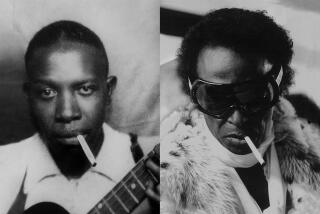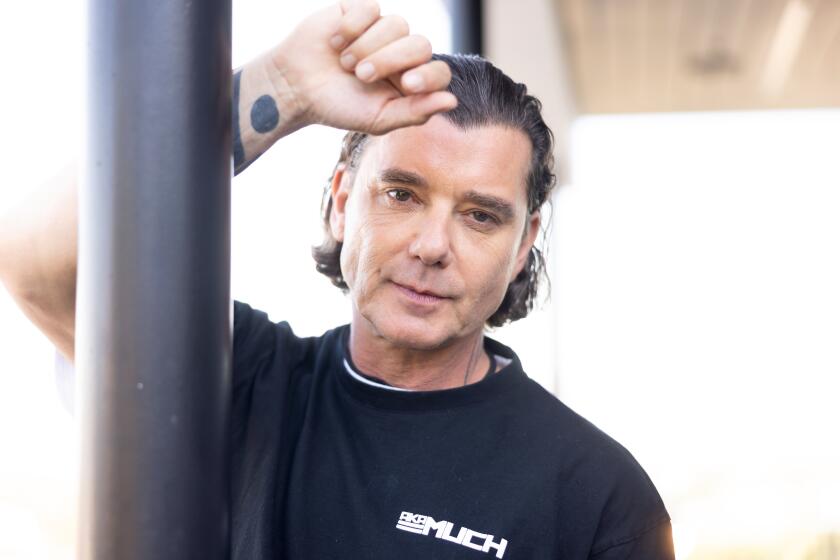Alice Coltrane’s ashram — and her ‘Black radical imagination’ — lives on at the Hammer Museum

- Share via
In 1972, Alice Coltrane moved her family from New Jersey to California with the goal of building an ashram. Settling in Agoura Hills, the jazz virtuoso and Hindu spiritual leader led a faith-based community for more than three decades. Coltrane died in 2007. In 2017, the secluded place of worship closed, only to be destroyed a year later in the Woolsey fire.
The Hammer Museum brings Coltrane’s ashram back to Los Angeles with its “largest” exhibition of the season, “Alice Coltrane, Monument Eternal.”
Curated by Erin Christovale, it’s the first exhibition to examine Coltrane’s life and legacy through art. Alongside a mix of ephemera and archival footage, the show features the works of 19 contemporary Black artists. From deconstructed pianos to sensory deprivation rooms that play her sermons to colorful laser projections, Coltrane’s legacy is in the hands of these American artists. Some were asked to create pieces that directly respond to her archives while others shared preexisting works that connect with Coltrane’s ethos.
“She’s a Black woman who found ways to liberate and emancipate herself in this society, in this world, on her own terms, and that’s what I take away from her legacy,” said Christovale. “She is a prime example of someone who exercised her Black radical imagination. She was generous enough to do that collectively with the people around her and to leave us with clues as to how to do that for ourselves. We absolutely need that type of thinking and imagination in the current state of the world.”

The show is divided into three themes: sonic innovation, spiritual transcendence and architectural intimacy. First, visitors are introduced to Coltrane, the musical virtuoso. Raised in Detroit, she began playing the organ for her church’s congregation at age 9. She also picked up the piano and the harp. By the early ’60s, she was a part of multiple traveling jazz groups. While playing with the Terry Gibbs Quartet in New York, she met famed saxophonist John Coltrane and got married in 1965. Later in life, she became a pioneer of spiritual jazz — where she blended unrehearsed rhythms with the sounds of her faith.
Marked by musically charged sculptures, such as Gozié Ojini’s disassembled piano keys and Jamal Cyrus’ saxophone — with ropes spewing out of its tone holes — the room explores Coltrane, the lifelong musician. Images of her and her husband touring and performing in Japan and pages from her family’s photo album fill the glass cases as Jasper Marsalis’ abstract paintings of musical performances hang on the neighboring wall.
Ojini, who was born in L.A., considers his participation in the show to be a homecoming, as he once worked the Hammer’s front desk while attending UCLA. His two pieces, “44.6 lbs” and “4.5 lbs,” debuted at his first solo show, “Passages,” in New York last spring. He said he relates to Coltrane because he grew up in a musical family and looks to music for inspiration.
“I’m in this mode of returning back to something that I couldn’t claim as mine,” Ojini said of his sprawled-out, destroyed piano structure. “There’s been a piano in my house for as long as I can remember. And I always felt estranged from music as a kid. So it’s been nice to finally kind of come back and be accepted into this global community.”

Last weekend, the Hammer celebrated the opening with a full-fledged party. As the night’s DJs controlled the dance floor and museum-goers wandered through the galleries, Hari Williams and Malik Vitthal were transported to a vital part of their childhood. The two friends grew up on Coltrane’s ashram — Williams lived there until he was 11 and Vitthal moved there when he was 8. Walking through the exhibit, Vitthal said he experienced the feeling “you get when you get out of church. It’s a lot to absorb.”
“I remember after the [2018] fires and remember after the land changed ownership, we were talking about whether the ashram existed as it did in the physical realm — especially with not being able to go there and conduct services like we were accustomed to,” said Williams. “But its spirit is something that we carry and embody wherever we go. So to be in a space where there’s a collection of so many things that feel familiar is really beautiful.”
Surrounded by decals of Coltrane’s albums, Williams and Vitthal stood in front of an installation that allows individuals to sit and listen to each of her projects. The pair walked over to the album cover of “The Ecstatic Music of Alice Coltrane Turiyasangitananda,” a compilation album released in 2017. They recognized familiar faces from the group photo and pointed to a little girl in a pink dress, who now goes by the stage name Doja Cat.
Reflecting on the creative lineage of artists like Doja Cat, who grew up on the ashram, and Coltrane’s grandnephew Steve Ellison, a.k.a. producer and DJ Flying Lotus, Williams and Vitthal said many of their peers have gone on to excel in their respective fields because of the environment they were raised in.

After the passing of John Coltrane, Alice turned to African and Eastern religions, specifically Hinduism, and took on the Sanskrit name Swamini Turiyasangitananda. The spiritual transcendence portion of the exhibit is marked by multiple television sets that play Coltrane’s show “Eternity’s Pillar,” in which she shared her teachings. Other works like Shala Miller’s “Heavenly Father” photo series, portraying a visitation dream from her deceased father, and Coltrane’s framed depictions of “Krishna” and “Rama,” fill the gallery.
Star Feliz, a New York artist now based in L.A., was exploring the connection between civilian oracles and artificial technologies in their art when they were approached to make a new piece for the show. A longtime fan of Coltrane, they turned specifically to Coltrane’s book “Turiya Speaks, Divine Discourses Volume I” for inspiration. The multimedia artist created an earth-toned concrete sculpture with a small screen and ethernet cables reaching toward the ceiling, called “Siren of Oblivion.”
“I really felt like this was an opportunity to strip down a lot and honor the connection to the heart and to spirit that is so present in [Coltrane’s] work,” Feliz said of how Coltrane influenced their creative process. “In my practice, spirit has always been there, but there’s always been this tinge of trauma and violence because of my ancestral history.”
The final section of the exhibit focuses on Coltrane’s ability to build worlds, like in her ashram and in her family home. Featuring a meditation hub and an installation that plays frequencies to align chakras, visitors exit the exhibition in a meditative state.
“One thing I can say without a doubt is that her music is healing. It’s cathartic. From a very young age, she understood the power of pairing the sonic realm with the spiritual realm. Her legacy has been about how to bring those two worlds together and what that can do for people,” said Christovale. “Now more than ever, we need that sort of sonic balm that her music provides.”
More to Read
The biggest entertainment stories
Get our big stories about Hollywood, film, television, music, arts, culture and more right in your inbox as soon as they publish.
You may occasionally receive promotional content from the Los Angeles Times.











